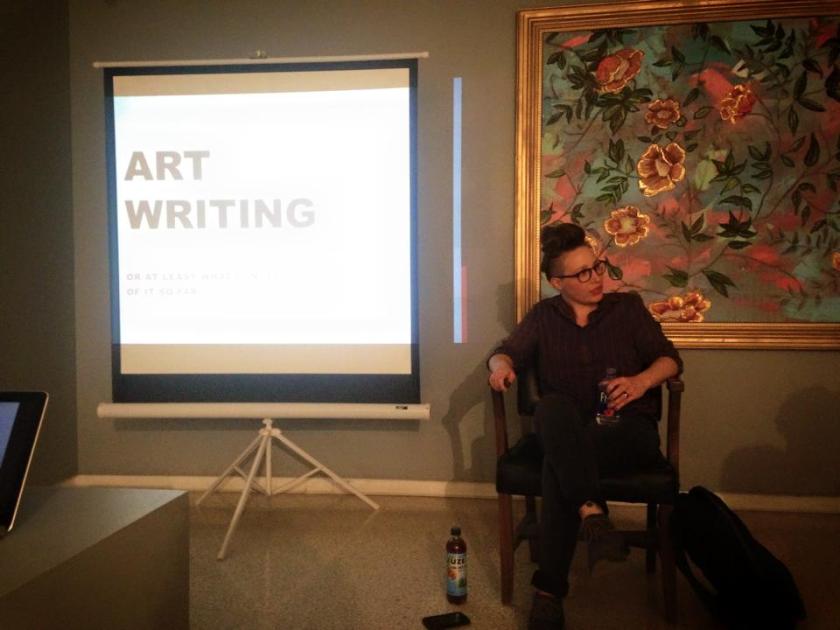A couple Thursdays ago I gave a talk at ETSU about art writing, which was also my first time doing anything like that. Thankfully I’ve spent a lot of time thinking about this subject so I had plenty to say and organization of the overall lecture came fairly easily.
In my own experience as a writer and an artist, I have noticed there are a lot of overlapping characteristics between the two roles. To make the prospect of writing about art more approachable, I thought using a known frenemy for illumination would be helpful.
1. There’s no substitution for doing the work — Exactly how it sounds. If you’re not in your studio working, you can’t hope to make improvements as an artist and the same goes for writing.
2. Self-motivation is necessary — No one cares if you stop writing or making art once you graduate, except for maybe a handful of people who love you. It takes time and diligence to keep yourself going.
3. Seemingly unrelated assignments can get you closer to your goals / interests — I like how Neil Gaiman described this necessity when talking about the early part of his career:
Sometimes the way to do what you hope to do will be clear cut, and sometimes it will be almost impossible to decide whether or not you are doing the correct thing, because you’ll have to balance your goals and hopes with feeding yourself, paying debts, finding work, settling for what you can get.
Something that worked for me was imagining that where I wanted to be – an author, primarily of fiction, making good books, making good comics and supporting myself through my words – was a mountain. A distant mountain. My goal.
And I knew that as long as I kept walking towards the mountain I would be all right. And when I truly was not sure what to do, I could stop, and think about whether it was taking me towards or away from the mountain.
4. Opportunities are sought, but also created — Opportunities exist for artists in a lot of different forms, such as juried exhibitions, exhibition proposals, grant proposals, etc. but there is also some creative problem solving required. Once we’ve made the work, how do we share it with people? How can we take steps toward our respective mountains?
I used Vision magazine, a student-run independent art publication in existence between 2007-2010 at ETSU, as an example. Robert Prowse, at the time a communications major who was friends with a lot of art students, recognized a deficit in art writing and exposure. Since he had experience selling advertisements for the East Tennessean, had taken some journalism courses and had connections with writers as well as artists, he was able to pull together strengths in various individuals (especially Ben Townsend Hamm, the art director of the magazine) to create a product that benefited many.
I wrote a few feature articles on students that they later used when applying to grad schools, which I also used when applying for writing jobs. When Jennifer Culp took over as editor, she was later able to use that experience for editorial and writing jobs. Some students learned about interviewing or reviewing subjects, other students learned about being interviewed and seeing their work discussed publicly in print. It was a support structure that was needed and created within the community. No one gave them permission to do it or handed them the tools.
5. Communication with a known and (hopefully) unknown audience — Bouncing off of the above point, well, even good things that people love can fall apart. One of the primary reasons that Vision didn’t survive was because it kept speaking to and pooling resources from it’s known audience. Students are by default a transient demographic. Narrower still are the fine or studio art students.
During my talk I quoted Scott Contreras-Koterbay’s article, Elephants As Free Radicals, on Dennis McNett’s visit to ETSU —
“I find myself often thinking at art world events that the only people who are there already approve of what’s being done; rarely do outsiders find their way into an art event, intimidated by the cliquishness of the community. Art that is for the art community merely speaks to the converted…”
Something I did not anticipate needing to do in regard to this talk was tricking artists and art students into caring about it. If we cannot stand to communicate or see ourselves translated for an audience, how can we possibly hope for anyone else to care? And if we only intend to speak to ourselves, to the converted, then what exactly is the point?
6. Engagement = Growth —
I ended my talk with two examples of how intentional and unintentional engagement with my community, which always involves some degree of willful vulnerability, stimulated questions, discussion, and growth. One worked out really well and the other did not.
When you’re writing about art and allowing it to exist within a larger context, it’s complexity and connections within vast territories grows. When you’re writing about art, you should be writing about people and life.


